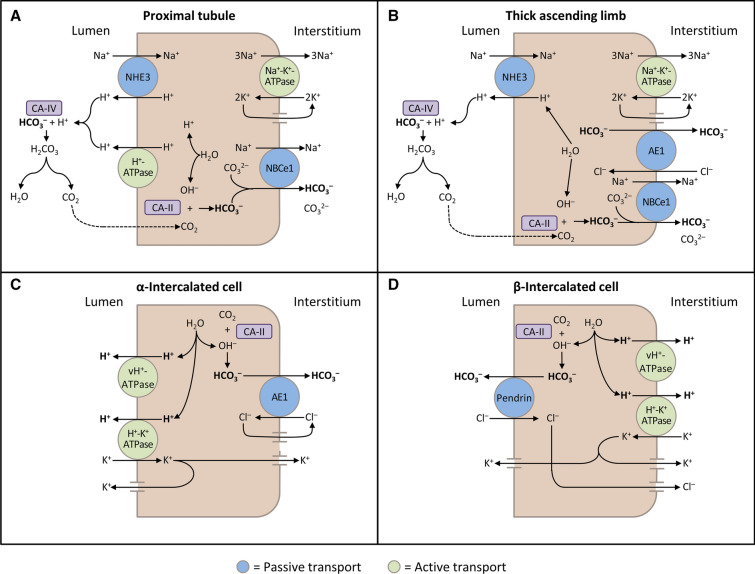Fig. 1.
Schematic diagrams illustrating bicarbonate (HCO3–) reabsorption and regeneration in the kidney. a HCO3– reabsorption in the proximal tubule. Hydrogen ions (H+) are secreted into the lumen via apical sodium (Na+)/H+ exchanger 3 (NHE3) and H+-ATPase transporters. Apical carbonic anhydrase (CA) IV catalyzes the reaction between H+ and HCO3–, which forms H2CO3 that rapidly dissociates to water and carbon dioxide (CO2). CO2 diffuses back across the apical membrane, where CA-II catalyzes its reaction with intracellular hydroxide ions (OH–) to form H+ and HCO3–. HCO3– is transported across the basolateral membrane by the Na+/HCO3–/CO32– cotransporter (NBCe1). b HCO3– reabsorption in the thick ascending limb. As in the proximal tubule, H+ is secreted into the lumen via NHE3, where it reacts with HCO3– to release CO2 that diffuses back across the apical membrane. HCO3– is transported across the basolateral membrane by NBCe1 and the kidney anion exchanger (AE1). c H+ secretion by α-intercalated cells in cortical collecting duct (CCD). H+ is secreted into the lumen by H+/K+-ATPase and vacuolar (v) H+-ATPase transporters on the apical membrane. Intracellular OH– generated by H+ secretion reacts with CO2 via CA-II to form HCO3–, which is removed by basolateral AE1. The resulting intracellular chloride (Cl–) exits via conductance channels in the basolateral membrane. Luminal K+ transported into the cell via H+/K+-ATPase can exit via channels in the apical or basolateral membrane, depending on K+ balance. d HCO3– secretion by β-intercalated cells in CCD. H+-ATPase transports H+ across the basolateral membrane. Intracellular OH– generated by H+ secretion reacts with CO2 via CA-II to form HCO3–, which is transported into the lumen by the apical Cl–/HCO3– exchanger pendrin. Intracellular Cl– exits via conductance channels in the basolateral membrane
(These figures were published in Comprehensive Clinical Nephrology: 5th Edition, Palmer BF, Normal acid–base balance, pp. 142–148, Copyright Elsevier (2014) [6])

